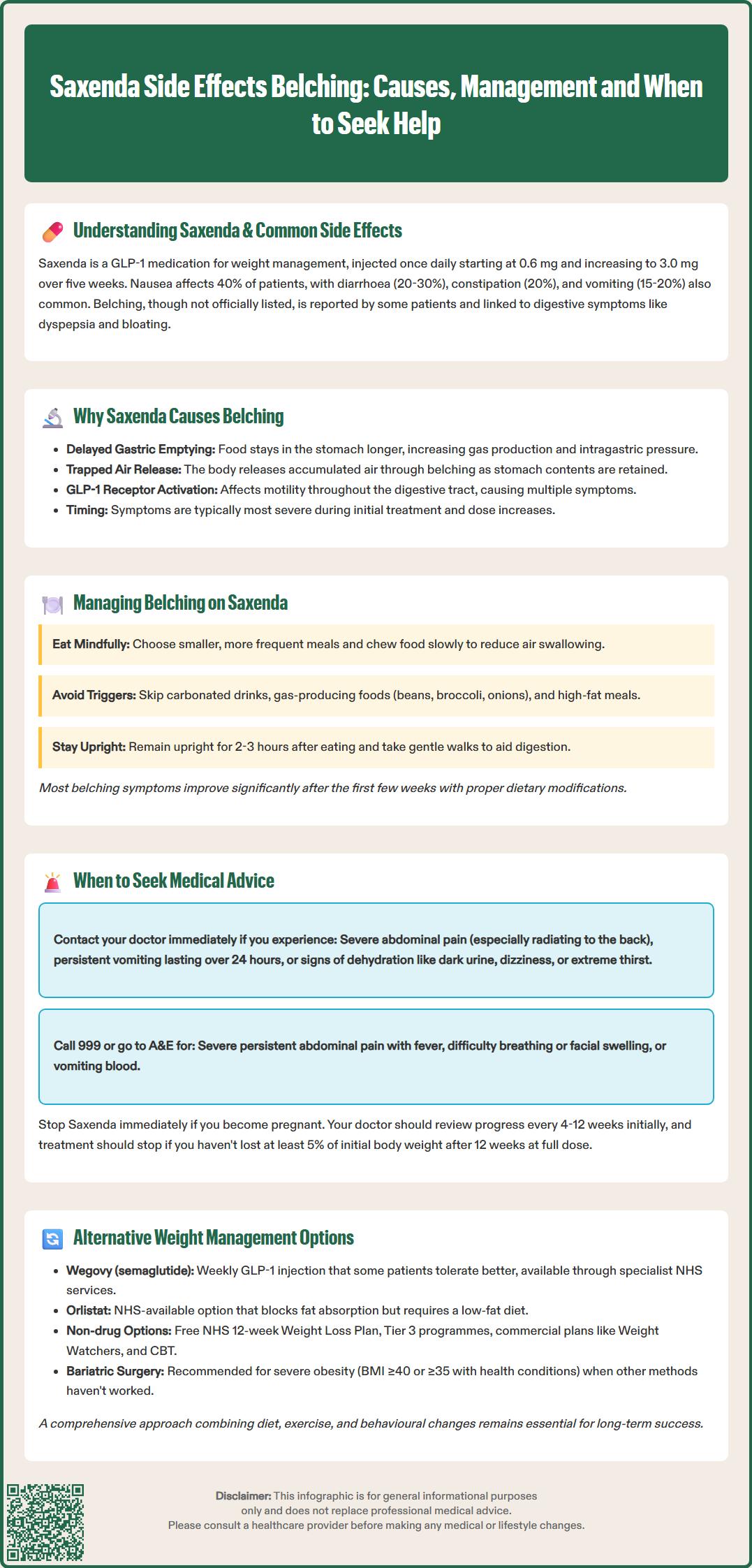LOSE WEIGHT WITH MEDICAL SUPPORT — BUILT FOR MEN
- Your personalised programme is built around medical care, not willpower.
- No generic diets. No guesswork.
- Just science-backed results and expert support.
Find out if you’re eligible

Saxenda (liraglutide 3.0 mg) is a GLP-1 receptor agonist licensed in the UK for weight management in adults and adolescents with obesity. Whilst Saxenda side effects belching is not specifically listed in the Summary of Product Characteristics, some patients report increased belching alongside other gastrointestinal symptoms such as nausea, dyspepsia, and bloating. These digestive effects relate to how liraglutide slows gastric emptying and affects gut motility. Most symptoms are mild to moderate, typically improving after the initial weeks of treatment. Understanding why belching occurs and how to manage it can help patients continue treatment effectively whilst minimising discomfort.
Quick Answer: Belching with Saxenda occurs because liraglutide slows gastric emptying, causing food to remain in the stomach longer, which increases gas production and intragastric pressure.
Saxenda (liraglutide 3.0 mg) is a prescription medicine licensed in the UK for weight management in adults with obesity (BMI ≥30 kg/m²) or overweight (BMI ≥27 kg/m²) with weight-related health conditions such as type 2 diabetes, hypertension, dyslipidaemia, obstructive sleep apnoea, or dysglycaemia/prediabetes. It is also licensed for weight management in adolescents aged 12-17 years with obesity. Saxenda belongs to a class of medications called glucagon-like peptide-1 (GLP-1) receptor agonists, which work by mimicking a naturally occurring hormone that regulates appetite and food intake.
Saxenda is administered as a once-daily subcutaneous injection, typically starting at a low dose (0.6 mg) and gradually increasing over five weeks to the maintenance dose of 3.0 mg daily. According to the MHRA-approved Summary of Product Characteristics (SmPC), this gradual titration helps minimise side effects, though gastrointestinal symptoms remain the most frequently reported adverse reactions.
The most common side effects reported in the SmPC include:
Nausea (affecting approximately 40% of patients)
Diarrhoea (20–30% of patients)
Constipation (approximately 20% of patients)
Vomiting (15–20% of patients)
Dyspepsia and abdominal discomfort
Flatulence
Whilst belching (eructation) is not specifically listed among the adverse reactions in the Saxenda SmPC, some patients report experiencing increased belching, which may be associated with other gastrointestinal symptoms such as dyspepsia, reflux or bloating. Most gastrointestinal side effects are mild to moderate in intensity and typically improve over time as the body adjusts to the medication. These symptoms are usually most pronounced during the dose escalation period and tend to diminish with continued treatment, though some individuals may experience persistent digestive changes.

The mechanism behind Saxenda-related digestive symptoms relates directly to how GLP-1 receptor agonists affect the gastrointestinal system. Liraglutide works by binding to GLP-1 receptors found throughout the gastrointestinal tract, pancreas, and brain. This binding triggers several physiological responses that contribute to weight loss but also produce digestive side effects.
Delayed gastric emptying is a recognised effect of liraglutide, as documented in the European Medicines Agency's European Public Assessment Report (EPAR) for Saxenda. This slowing of stomach emptying contributes to feelings of fullness and satiety—key to the medication's weight-loss effects—but also means food remains in the stomach for longer periods. When gastric contents are retained, there may be increased:
Gas production from food digestion
Air swallowing (aerophagia) during eating, which becomes more noticeable
Increased intragastric pressure, potentially leading to belching as the body releases trapped air
Reflux of stomach contents, which may trigger additional belching
It's worth noting that the gastric emptying delay is typically most pronounced during initial treatment and tends to diminish over time with continued use, which may explain why digestive symptoms often improve after the first few weeks.
The effects on gastrointestinal motility may also contribute to altered digestive patterns. These changes affect not only the stomach but potentially the entire digestive tract, explaining why patients may experience a constellation of symptoms including belching, bloating, flatulence, and altered bowel habits. Understanding these mechanisms helps explain why symptoms are typically most pronounced during the initial weeks of treatment and during dose increases, when the body is still adapting to the medication's effects on digestive function.
Whilst belching and digestive discomfort can be bothersome, several practical strategies can help minimise these symptoms whilst continuing Saxenda treatment. Most patients find that symptoms improve significantly after the first few weeks, particularly if they implement dietary and lifestyle modifications.
Dietary adjustments represent the first-line approach to managing belching:
Eat smaller, more frequent meals rather than large portions, which can overwhelm the already-slowed digestive system
Chew food thoroughly and eat slowly to reduce air swallowing
Avoid carbonated beverages, which introduce additional gas into the digestive system
Limit gas-producing foods such as beans, lentils, cruciferous vegetables (broccoli, cauliflower, cabbage), onions, and certain fruits during the initial adjustment period
Reduce fatty foods, as high-fat meals are particularly slow to digest and may exacerbate symptoms
Identify personal trigger foods through a food diary, as individual responses vary
Eating habits and lifestyle modifications also play an important role:
Avoid lying down immediately after eating; remain upright for at least 2–3 hours
Take time during meals rather than eating hurriedly, which increases air swallowing
Avoid chewing gum and sucking on hard sweets, both of which promote aerophagia
Stay well-hydrated throughout the day, but avoid drinking large volumes with meals
Consider gentle physical activity after eating, such as a short walk, to aid digestion
It's advisable to take Saxenda at a consistent time each day. If gastrointestinal symptoms are particularly troublesome during dose escalation, the SmPC notes that clinicians may consider delaying dose increases by an additional week.
For persistent symptoms, consult your pharmacist or GP before using over-the-counter remedies such as simethicone (an anti-foaming agent), which may provide relief for some people. Importantly, do not stop or reduce your Saxenda dose without medical guidance, as this may affect treatment efficacy.
If you experience significant heartburn or acid regurgitation alongside belching, discuss this with your healthcare provider, as additional management strategies may be appropriate.
Whilst belching and mild gastrointestinal symptoms are expected with Saxenda, certain situations warrant prompt medical attention. It is important to distinguish between common, manageable side effects and symptoms that may indicate more serious complications.
Contact your GP or prescribing clinician if you experience:
Severe or persistent nausea and vomiting that prevents adequate fluid or food intake, as this may lead to dehydration
Severe abdominal pain, particularly if constant or radiating to the back, which could indicate pancreatitis (a rare but serious side effect)
Persistent vomiting with inability to keep down fluids for more than 24 hours
Signs of dehydration: dark urine, dizziness, reduced urination, extreme thirst, or confusion
Unexplained weight loss beyond expected therapeutic effects, or inability to maintain adequate nutrition
Symptoms of gallbladder disease: severe right upper abdominal pain, particularly after eating, with or without jaundice (yellowing of skin or eyes)
If you become pregnant: Saxenda is contraindicated in pregnancy and not recommended during breastfeeding. Stop taking it immediately and contact your prescriber if you become pregnant
Seek immediate medical attention (call 999 or attend A&E) if you develop:
Severe, persistent abdominal pain with fever and rapid pulse (possible pancreatitis)
Symptoms of severe allergic reaction: difficulty breathing, facial swelling, or widespread rash
Severe dehydration with altered consciousness or inability to stand
Persistent vomiting with blood or coffee-ground appearance
If you have diabetes and are also taking insulin or sulfonylureas (e.g., gliclazide), be aware of the increased risk of hypoglycaemia and discuss monitoring and dose adjustments with your healthcare team.
Additionally, routine monitoring is important during Saxenda treatment. Your prescriber should review your progress regularly, typically at 4–12 week intervals initially. According to the Saxenda SmPC, treatment should be discontinued if patients have not lost at least 5% of initial body weight after 12 weeks at the maintenance dose (3.0 mg daily). Regular reviews allow assessment of both efficacy and tolerability, with opportunity to adjust treatment if side effects become unmanageable.
If belching or other gastrointestinal symptoms significantly impair your quality of life despite implementing management strategies, discuss this with your healthcare provider. Alternative weight management approaches may be more suitable for your individual circumstances.
You can report any suspected side effects to the MHRA through the Yellow Card Scheme at yellowcard.mhra.gov.uk or via the Yellow Card app.
For patients who cannot tolerate Saxenda due to belching or other side effects, or for whom it is contraindicated, several alternative weight management options are available through the NHS and private healthcare in the UK.
Other pharmacological options include:
Orlistat (Xenical, Alli): A lipase inhibitor that reduces fat absorption from the diet. Available on NHS prescription for eligible patients (BMI ≥30 kg/m² or ≥28 kg/m² with risk factors). Orlistat has different side effects, primarily gastrointestinal symptoms related to fat malabsorption, and requires a low-fat diet for tolerability. According to NHS guidance, treatment should be reviewed after 12 weeks and discontinued if less than 5% of body weight has been lost.
Wegovy (semaglutide 2.4 mg): Another GLP-1 receptor agonist, administered weekly rather than daily. Whilst it shares a similar mechanism to Saxenda and may cause comparable gastrointestinal side effects, some patients tolerate one GLP-1 agonist better than another. NICE Technology Appraisal (TA875) recommends semaglutide for adults with at least one weight-related condition and a BMI of at least 35 kg/m² (or exceptionally 30-34.9 kg/m² in certain circumstances), within a specialist weight management service.
Non-pharmacological approaches form the foundation of weight management and may be sufficient for many patients:
NHS Weight Loss Plan: A free 12-week diet and exercise programme available online, providing structured support without medication
Tier 3 weight management services: Specialist multidisciplinary programmes available through NHS referral, offering intensive dietary, psychological, and physical activity support
Commercial weight loss programmes: Services such as Weight Watchers (WW) or Slimming World, which may be available on NHS referral in some areas
Psychological support: Cognitive behavioural therapy (CBT) or other psychological interventions addressing eating behaviours and emotional factors
Bariatric surgery represents an option for patients with severe obesity (BMI ≥40 kg/m² or ≥35 kg/m² with obesity-related conditions) who have not achieved adequate weight loss through other methods. NICE Clinical Guideline 189 recommends considering surgery as a first-line option for adults with BMI ≥50 kg/m². Referral is typically through tier 3 services to tier 4 (surgical) services.
Your GP can discuss which options are most appropriate for your individual circumstances, considering your BMI, co-existing health conditions, previous weight loss attempts, and personal preferences. A comprehensive approach addressing diet, physical activity, and behavioural factors remains central to successful long-term weight management, whether or not medication is used.
Whilst belching is not specifically listed in the Saxenda Summary of Product Characteristics, some patients report increased belching associated with other gastrointestinal symptoms such as dyspepsia, bloating, and reflux. These symptoms typically improve after the initial weeks of treatment.
Most gastrointestinal side effects, including belching, are most pronounced during the dose escalation period and typically improve significantly after the first few weeks as the body adjusts to the medication. Some individuals may experience persistent but milder digestive changes.
Eat smaller, more frequent meals, chew food thoroughly, avoid carbonated beverages and gas-producing foods, remain upright for 2–3 hours after eating, and stay well-hydrated. If symptoms persist despite these measures, consult your GP or pharmacist for further advice.
All medical content on this blog is created based on reputable, evidence-based sources and reviewed regularly for accuracy and relevance. While we strive to keep content up to date with the latest research and clinical guidelines, it is intended for general informational purposes only.
DisclaimerThis content is not a substitute for professional medical advice, diagnosis, or treatment. Always consult a qualified healthcare professional with any medical questions or concerns. Use of the information is at your own risk, and we are not responsible for any consequences resulting from its use.